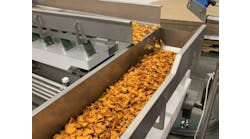Unlike a professional athlete, an electric motor will never give 110 percent, and with premium low-voltage induction motors delivering energy efficiency ratings in the low 90s, there isn't much room for additional improvement on that front.
The same can't be said about servo motors and drives, a technology much less mature than induction motors and with plenty of room for advancement. Higher speeds and lower purchase costs ensure that the induction motor long will be with us, but the superiority of servos in many applications, along with their declining costs and user-friendly configurations, are helping them carve out a bigger role in food and beverage plants.
"Fifteen or 20 years ago, it was tough to get processors to transition to servos, even when they were a superior alternative," reflects Terry Bell, product manager-rotary and linear servo motors at Baldor Electric Co., Fort Smith, Ark. "Today, everyone is looking at the overall cost of production, so they have to factor in the size and efficiency of the motors and their impact on the true cost of producing the product." Often, that means using servos.
Baldor is synonymous with the induction motor, and its acquisition by ABB in 2011 seemingly would have ended its involvement with servos. Instead, the division continues to invest in the technology, with a stainless steel servo motor for washdown applications representing a recent addition to its line. Visitors to Fort Smith do a double take when Bell brings them through Baldor's fabrication facility, where servos produce the windings and execute other assembly tasks in outputting 5,000 induction motors a day.
Kevin Higgins is the Managing Editor of Food Processing Magazine. You can email him at [email protected] or check out his Google+ profile.
Portioning of chicken parts into nuggets, fingers and other servings for foodservice was strictly a manual operation until recent years, when an OEM combined vision technology with a servo-driven waterjet cutting unit, according to Joe Carey, industrial application engineer for packaging and motion control at ABB Inc. in New Berlin, Wis. Servo technology enabled suppliers to fast-food operators to leapfrog conventional power options entirely to improve throughput and yield.
Servo motors are most frequently found in food plants packaging departments, and the transition to servos is almost complete in some categories, says Carey. "There are more than 100 U.S. manufacturers of form/fill/seal machines, and 10 years ago they used stepper motors to feed and index containers," he says. "Now, close to 100 percent are using servo technology," making the process continuous. One client's machine now is able to output more than 120 small bags a minute, compared to only 80 with the previous stepper-motor design.
Bridging the IT divide
Machine OEMs are typically the primary customers of servo suppliers, and they benefit most directly from the technology's advancements. An exception to the rule is Open Core Engineering, a programming and troubleshooting platform from Bosch Rexroth Corp. that connects plant-floor and IT automation through mobile devices.
Introduced in February, Open Core Engineering lets OEM engineers interface through smart phones and tablets with machine controls for Rexroth's drives and motors.
"He can write his own code and provide remote communication and diagnostics with smart devices," explains Jim Hulman, business development manager for packaging and printing at Rexroth in Hoffman Estates, Ill. "You no longer need to tap into the plant's ERP to access and receive machine data."
The software engineering app eliminates IT security concerns over granting machine access through plant communications networks and "combines the PLC world and the IT world into one port," adds Hulman.
Cabling is a significant cost in servo systems, and Rexroth tackled the issue in 2005 when it combined power and feedback in a single cable to its integrated servo motor and drive. Until then, a machine with 10 motors would require 20 cables running back and forth to a centralized control cabinet. Rexroth changed that with a single cable that was daisy-chained to the next nine motors.
Beckhoff Automation, Savage, Minn., is another servo supplier that provides stainless steel motors for the new process applications in food plants. Beckhoff also transitioned to single-cable technology in 2011. The simplified connectors improved power utilization by 10 percent. It also advanced the move to open architecture that allows machine users to select the best system components for their applications, points out Joe Martin, packaging and converting manager.
"Sercos was the de facto standard for 20 years, but now we're able to use Ethercat for both communications and motion control networking," he says. "We've also eliminated switches, routers and other components, and when you start eliminating components, reliability goes up."
Single-cable servos likely will be available in the near term from ABB, Carey reports, which will enable absolute encoder feedback for better control and accuracy. The biggest benefit for end-users likely will be cost savings, however: "On small units, two cables can be half the cost of the motor," he estimates.
It took time for food processors to develop a comfort level with servo motors and drives. Now that they have, they are poised to take advantage of incremental improvements that may well exceed 110 percent in the coming years.
This article originally appeared in the May 2013 issue of Food Processing Magazine.


